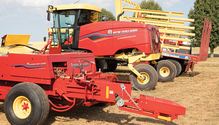
As we get into the new year, a lot of farmers are concerned about cash flow on their farming operations. With inflated interest rates, a higher cost of production, lower commodity prices, and rising equipment costs, it’s tougher to squeeze that quarter out of a penny, or however the saying goes, but you get the idea.
I haven’t given you my thoughts on equipment values and where they are heading in a while, so I figured this might be a good time to look into the new year and what it may mean for future equipment purchases.
Make no mistake about it, we will feel the effects of slower production brought on by the pandemic for years to come. Never in our history have we seen such an abrupt slowdown in manufacturing of equipment and parts.
Brighter days ahead
Fortunately, we should again start to see equipment line up on dealers’ yards this year. The manufacturers are already starting to ask for more orders from their dealers, which means they do not have all of their production slots full for 2024. This was not the case two years ago. Manufacturers were turning down orders, as they could not fill them.
In the past, when the equipment manufacturers were searching for orders, this would be a good thing for the end user. It would lead to higher incentives to purchase new equipment and drive more used equipment into the market. Now, the large amount of used equipment being traded in is at least 5 years old and has higher hours and bale counts. The search for low-hour, 2- or 3-year-old units is still tough sledding. The previous normal number of units is just not there.
Some of the larger manufacturers are back to pushing the multi-unit discount (MUD) deals to move a larger portion of their new inventory. These multi-deals were really hard to come by two years ago. Thus, the inventory of these 2- and 3-year-old units is not out there. With the low-hour units being hard to find, this has led to the older machines having elevated pricing relative to the actual market.
Larger machines like choppers and big square balers are going to be set up for a big difference between new and used later this year. When the manufacturers start offering lower interest rates coupled with some incentives to purchase new, this will lead to some new sales with trades coming into the market.
High interest adds to cost
I think the trouble will be finding the buyer for the used chopper that may cost $400,000, and this customer will have to finance it at 6.5% for five years. Such a scenario will almost certainly add $70,000 just in interest to the cost of the used unit. So, as a used machinery customer, when you know that you have to possibly add $50,000 to $100,000 to the purchase price for interest, I think that will be a major factor into what a customer is willing to spend on a used unit.
There will still be the exceptions at auctions and farm sales, but for a lot of smaller farmers, they are starting to have flashbacks of the late 1970s and early 1980s. In those days, you didn’t (or couldn’t) finance everything and tried your best to make cash purchases. I think this mentality will surface once again, though with the cost of equipment today, we may not be able pay for the entire unit, but rather try to put 50% to 75% down to get the payments affordable and limit the interest portion of the transaction.
Look for a new deal
If you are looking to purchase equipment this year, I think there will be some deals to be had on new equipment, which will be coupled with reduced interest rates. On the used side, I still believe that patience will win out. Do some homework on the values of the used equipment you are looking for.
Finally, don’t be afraid to purchase something from far away. Use your local dealership that you trust to help you purchase and inspect the used unit. Most dealers would rather keep you as a customer for parts and service than lose you because they’re upset you didn’t purchase a used unit from them. Being honest and upfront has always worked best for me.
This article appeared in the March 2024 issue of Hay & Forage Grower on page 34.
Not a subscriber? Click to get the print magazine.

